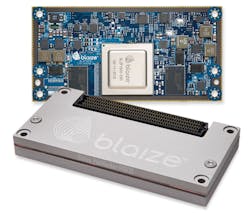Designers continue to push the envelope when it comes to supporting artificial intelligence (AI) and machine learning (ML). Hardware acceleration is still the name of the game when it comes to lowering power and increasing performance. CPUs and GPUs remain useful and can handle many of these chores, but ML hardware is now the cutting edge.
Blaize finally revealed is ML hardware solution based on its graph streaming processor (GSP) architecture. The company’s first platform delivers 16 TOPS of performance while snarfing 7 W of power. The claim is “GSP delivers up to 60X better system-level efficiency vs. GPU/CPUs for edge AI applications. In addition, GSP enables 50X less memory bandwidth, and 10X lower latency.”
A combination of specialized data caches and a hardware scheduler allow the GPS cores to process a portion of an ML model in a way that minimizes the intermediate results often plaguing other ML hardware attempting to process a node at a time. This is handy as the weights for a node remain constant and are swapped out for the next node in the chain. Essentially, the GPS cores implement a data-flow machine.
The Pathfinder P1600 is a system-on-module (SOM) that runs 16 GSP cores (Fig. 1). As mentioned, it only requires 7 W of power to deliver 16 TOPS of performance. Incorporated are a MIPI CSI/DSI camera and display and a x4 PCIe Gen 3 interface. H.264/H.265 video encode and decode is supported in hardware. The module is available with up to 8 GB of 32-bit LPDDR4 memory. It’s priced at $399.
The Pathfinder P1600 is designed for embedded applications on the edge. The same is true for the X1600E EDSFF small-form-factor module (Fig. 2), which can be used individually but will more often reside in a pluggable rack array. EDSFF was initially popularized for solid-state disks (SSD) with a PCIe interface that also supported NVMe based on PCIe. Of course, the PCIe interface can be used for other peripherals as well, including ML accelerators. A total of 36 EDSFF modules can fit into a single 1U rack. The X1600E costs $299.
The X1600P (Fig. 3) allows the GSP-based SoC to be plugged into a PC’s PCIe slot. The half-height, half-width board is essentially a carrier board with an X1600E installed. The X1600E has the same power requirements and performance as the Pathfinder P1600. The X1600P goes for $999.
Picasso is Blaize’s software development kit (SDK). Its AI Studio is a GUI application that can be used to create models without any programming.
About the Author
William G. Wong
Senior Content Director - Electronic Design and Microwaves & RF
I am Editor of Electronic Design focusing on embedded, software, and systems. As Senior Content Director, I also manage Microwaves & RF and I work with a great team of editors to provide engineers, programmers, developers and technical managers with interesting and useful articles and videos on a regular basis. Check out our free newsletters to see the latest content.
You can send press releases for new products for possible coverage on the website. I am also interested in receiving contributed articles for publishing on our website. Use our template and send to me along with a signed release form.
Check out my blog, AltEmbedded on Electronic Design, as well as his latest articles on this site that are listed below.
You can visit my social media via these links:
- AltEmbedded on Electronic Design
- Bill Wong on Facebook
- @AltEmbedded on Twitter
- Bill Wong on LinkedIn
I earned a Bachelor of Electrical Engineering at the Georgia Institute of Technology and a Masters in Computer Science from Rutgers University. I still do a bit of programming using everything from C and C++ to Rust and Ada/SPARK. I do a bit of PHP programming for Drupal websites. I have posted a few Drupal modules.
I still get a hand on software and electronic hardware. Some of this can be found on our Kit Close-Up video series. You can also see me on many of our TechXchange Talk videos. I am interested in a range of projects from robotics to artificial intelligence.




